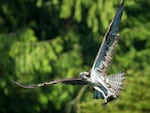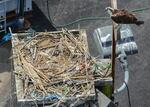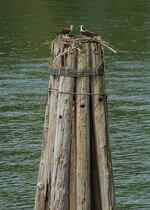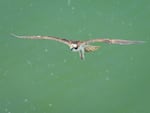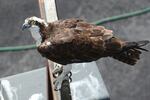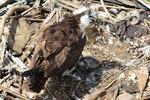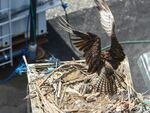Producer - Vince Patton
Videographers - Tom Shrider, Todd Sonflieth, Nicholas Fisher
Editor - Nicholas Fisher
Intern - Alexi Horowitz
Special Thanks - Gunderson Marine
Additional Photos & Video - Vince Patton, Jim Cruce, Harold Hutchinson, Magaurn Video Media, Prelinger Archives
__________________________________________________
On the banks of the Willamette River in industrial northwest Portland,
makes 17 railroad cars a day, builds an ocean-going barge every couple of months and raises two or three osprey chicks each year.
The company didn't set out to open a wildlife care center. The birds just invited themselves in.

An osprey crouches over two chicks and an unhatched egg.
Vince Patton / OPB
"Yes, we take care of birds," says Marvin Walz, material handling coordinator at Gunderson. "They're fun to watch."
Several years ago a pair of osprey started
right on one of the company's heavy lift cranes. If they'd laid eggs there, Gunderson would have to stop using the crane altogether until the federally protected birds had hatched their chicks, raised them and flown away.

A heavy lift crane at Gunderson Marine in Portland.
Vince Patton / OPB
"We do have another crane," says Walz, "But to not disturb them would have been extremely challenging."
Gunderson quickly followed advice from the
. Foreman Nick Anderson built a platform to attach to a nearby light pole. Then he moved the osprey's nest to it.
The birds moved the sticks back to the crane.
Nick moved them again.
So did the birds.
So did Nick.
Finally, the osprey took the hint.
Anderson says, "It was amazing how that happened. Now they're back again. Maybe they'll be there every year until they die because they mate for life."
The roar of generators, banging metal, piercing horns and the cacophony of heavy industry seems to have no effect.
"That is amazing," says Walz. "I wear my earplugs all day, every day and their hearing has to better than mine. Yet, they chose to live here."
LIke clockwork, the pair have returned year after year and has successfully hatched chicks. In April this year Gunderson workers spotted edges in the nest on the pole. Their 200-ton crane provides the perfect perch for peering down into their nest.
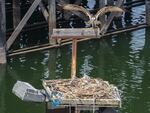
An osprey prepares to hop from its perch to a nest on top of a platform on a pole at Gunderson Marine in northwest Portland.
Vince Patton / OPB
Walz says, "I like the birds. I check every day.and get a report. When they get ready to hatch we'll be watching real close."
One of the nation's foremost experts on
, Chuck Henny, lives in Corvallis. He says osprey have adapted to human activity not just by coping with our disturbances but by embracing them, calling them home.
"Ospreys can habituate to man and his activities," says Henny, "It's unbelievable for a bird of prey to do that. I think it's pretty unique to the osprey."
Henny, a retired biologist for the USGS, spent more than 30 years studying osprey. He has spotted ospreys raising chicks on poles above active ball fields, on river channel markers and on top of dozens of utility poles. They are the only hawks that dive into water to grab live fish to eat.
Osprey, like eagles, suffered from the
. After the farm poison was banned in 1972, their numbers rebounded.
In 1976, Henny's survey found 13 pairs of osprey between Eugene and Portland. In 2008 he found 275 pairs.
He thinks they've learned that human-made structures support their nests better than trees. "I think they're actually more stable than tree nests," says Henny. "Some of the tree nests are a little shaky."
At Gunderson Marine, the annual osprey nest took an unwanted turn. On June 27th, one chick disappeared. By July 2nd the last remaining chick was gone too.
Perhaps they fell prey to a hungry bald eagle who'd begun hanging out nearby.
"Nobody knows for sure what happened," says Marvin Walz. "There's disappointment that they're gone and the show is over."
It's not how anyone hoped this story would end.
But this is nature.
The Gunderson workers hope the birds will return yet again next year as seems to have become their habit.

Osprey flies with a fresh fish catch in its talons.
Vince Patton / OPB
Henny, the biologist, isn't worried about the future of osprey.
Says Henny, "You know, I'm thinning that there may be more ospreys in Oregon now than there ever was."
He stopped his research and retired. No one has stopped in to continue the work because the birds are doing so well.
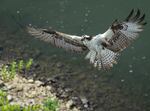
An osprey spreads its wings moments before landing on its nest.
Vince Patton / OPB

